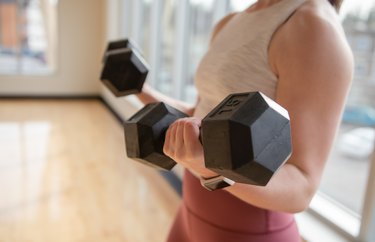
Although it may seem impossible, it's perfectly realistic to work out with a broken tibia and fibula. However, broken leg exercises do require some modification. You need to stay off your feet and out of the water — at least until you start rehabilitation.
Read more: Rehab Exercises for a Broken Tibia or Fibula
Video of the Day
Video of the Day
Managing a Broken Leg
The tibia and fibula are both bones found in your lower leg. According to the American Academy of Orthopaedic Surgeons, the tibia is one of the most commonly fractured bones in the body. Many people with tibia fractures have fibula fractures as well.
The treatment for tibia and fibula fractures typically involves splinting, casting and bracing. Most people will require a wheelchair, walker or crutches for six to eight weeks.
Out of all of these options, crutches allow you the most mobility. However, one of the most common problems with crutches is that people still feel their mobility is restricted.
A November 2019 study in the Technology in Society Journal reported that most users of crutches feel that they are unable to walk on stairs, bridges, uneven roads and hills. Other common problems with crutches include their inability to be used in wet areas — from slippery surfaces to outdoors in rainy weather.
Given how long the recovery period is for a broken leg, this restricted mobility can make people feel quite frustrated. This feeling is often exacerbated, since it can be challenging to work out.
A lot of popular exercises — especially core exercises — require you to stand or put your weight on your feet, knees or legs. For example, core exercises like the plank, side plank, bird dog and squat are all great ab workouts. However, there's no chance of doing any of these ab workouts with a broken leg.
This doesn't mean you can't exercise at all, though. You're may simply need to work with your doctor or physical therapist to custom-design a workout plan based on your needs. Most people will still be able to perform many arm and core exercises, as well as various different stretches throughout the recovery process.
Warning
Make sure you talk to your doctor or physical therapist before exercising with a broken bone or any other serious type of injury.
Broken Leg Exercises and Workouts
Your mobility may be limited and getting to a gym might be close to impossible, but there's nothing keeping you from doing broken leg exercises while lying in bed or sitting on a chair. Although it may seem challenging at first, you're doing yourself a favor.
According to a February 2017 study in the Climacteric Journal, exercise and good nutrition can help prevent future breaks and injuries. Vitamin D, calcium and protein are all essential for bone and muscle health.
Read more: Ab Exercises for the Bed
1. Start With a Stretch
You should always start broken leg exercises with stretches. The American Council on Exercise says that stretching can help reduce stiffness and improve circulation and range of motion. Focus on upper body stretches, but don't ignore the leg that isn't broken. You can still perform gentle leg stretches with that single leg.
2. Work Your Arms With Dumbbells
You can easily work your arms while lying down or seated. One of the easiest broken leg exercises you can do is the dumbbell bench press, which allows you to work out while lying down.
- Lay down with a dumbbell in each hand.
- Move the weights so that your arms are bent and each dumbbell is held to the side of your chest.
- Bring the dumbbells up above your chest, then slowly bring them down. You should feel a slight stretch in your chest/shoulder region.
- Repeat 8-to-10 times. You may wish to start with 2-3 sets, depending on the weight of the dumbbells.
3. Work Your Core With Crunches
Crunches for a broken leg may seem ambitious. However, this exercise is important, as it's one of the few ab workouts with a broken leg that you can do. These modified crunches for a broken leg keep your leg elevated but still allow you to work out your core and burn calories.
- Lay down, resting your legs on a chair. Clasp your hands behind your head.
- Raise your upper body while curling your back. Pause, then lower yourself back down.
- Repeat 15-to-30 times.
Once your cast comes off, you'll be able to start getting your leg back to full strength. Don't expect this to be immediate, though — it can take a few months to fully recover from a broken leg.
- Climacteric: "Exercise and Nutritional Approaches to Prevent Frail Bones, Falls and Fractures: An Update"
- American Council on Exercise: "10 Reasons Why You Should Be Stretching"
- Technology in Society: "Common Problems With the Conventional Design of Crutches: Proposing a Safer Design and Discussing the Potential Impact"
- American Academy of Orthopaedic Surgeons: "Tibia (Shinbone) Shaft Fractures"
Was this article helpful?
150 Characters Max
0/150
Thank you for sharing!
Thank you for your feedback!